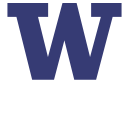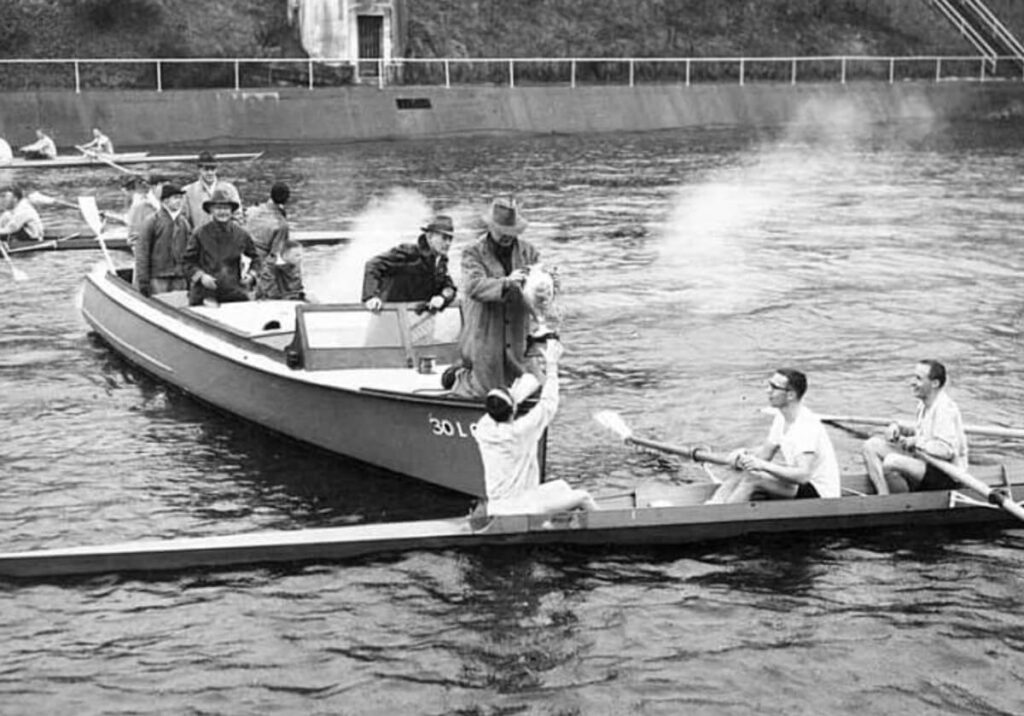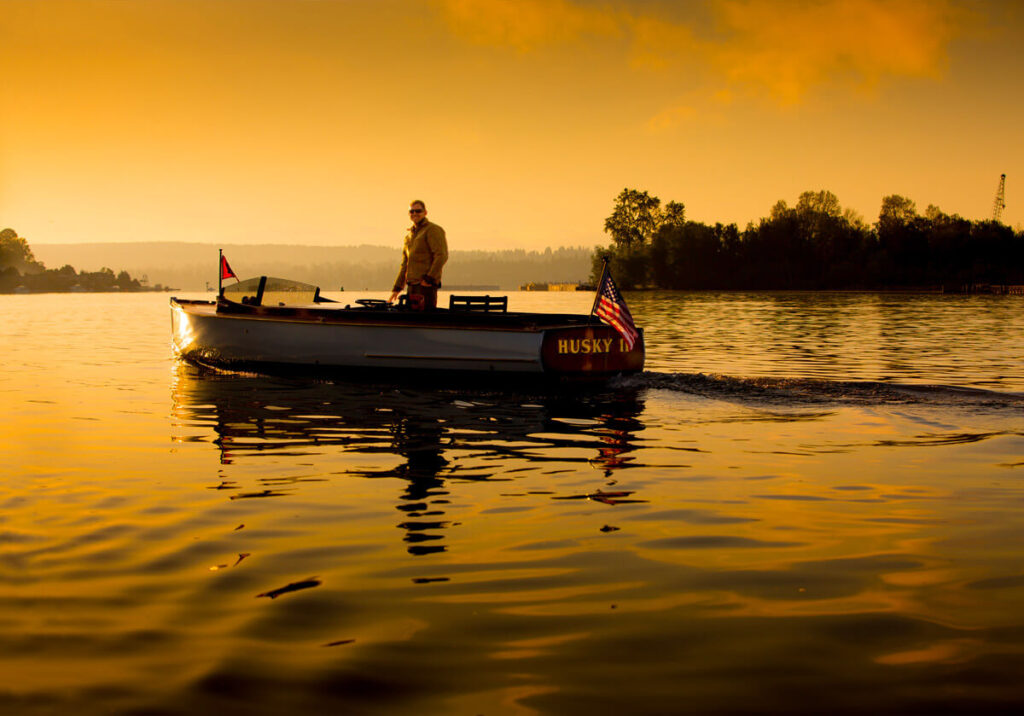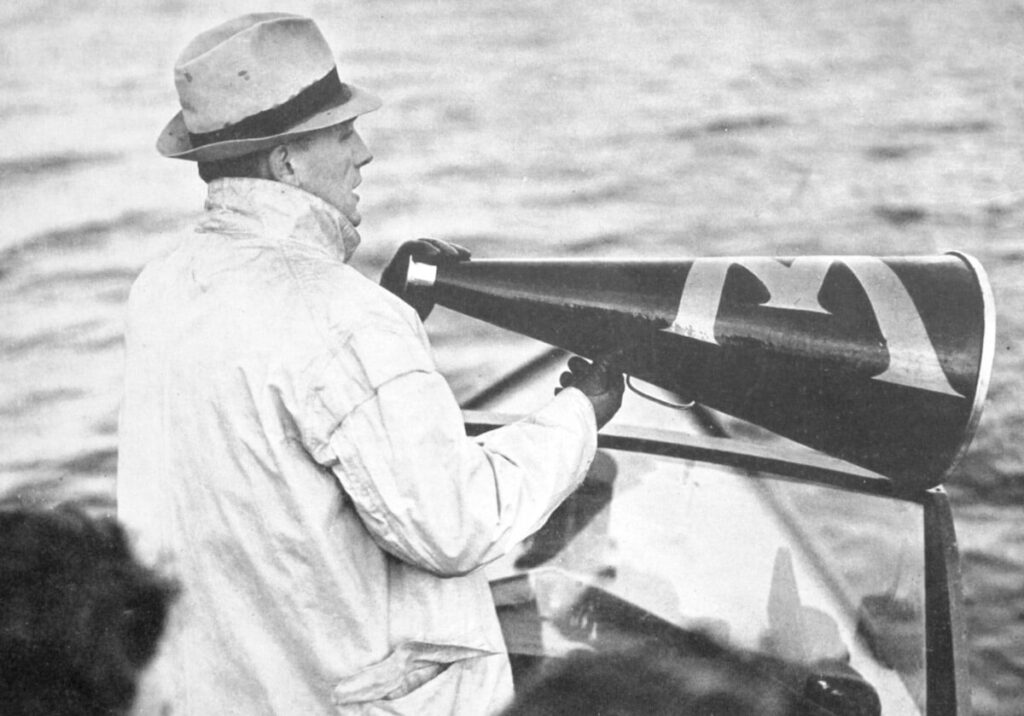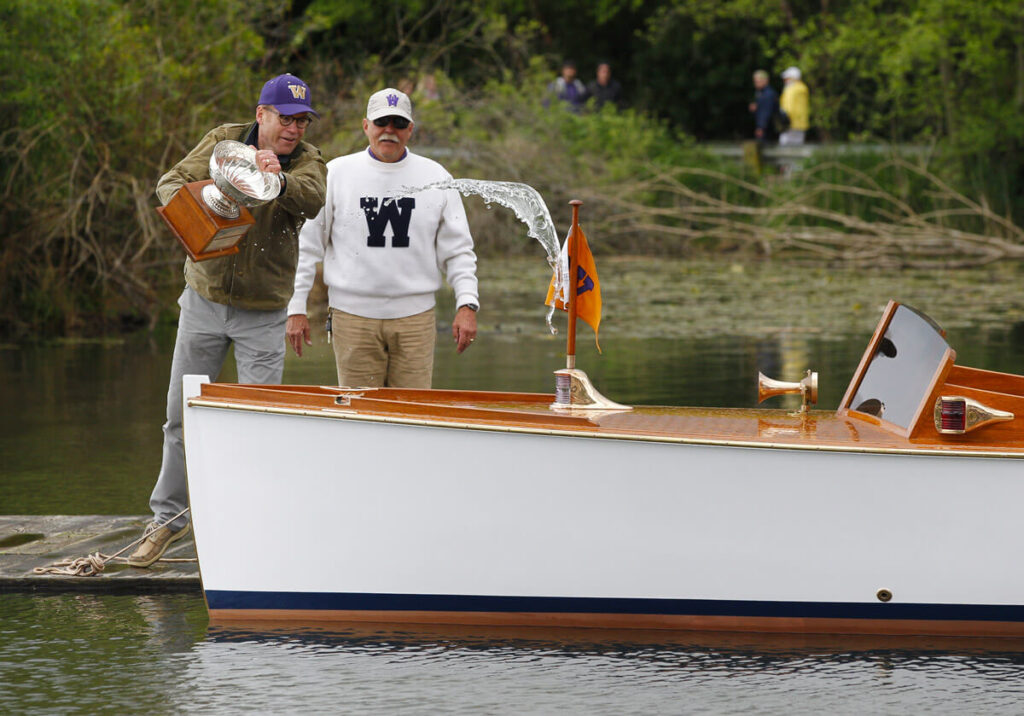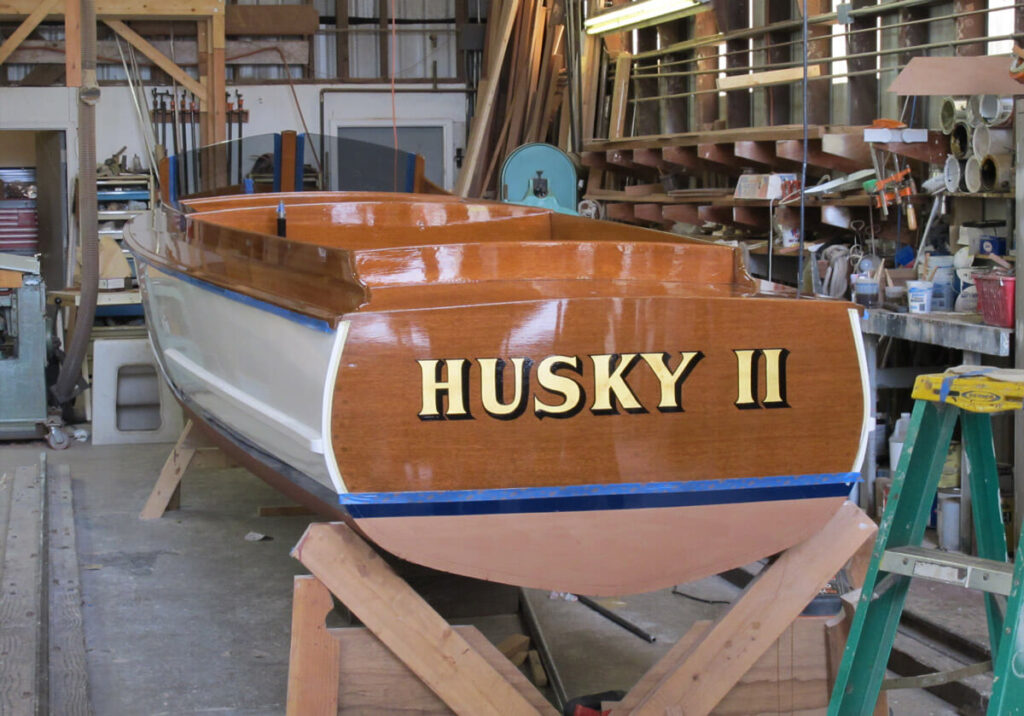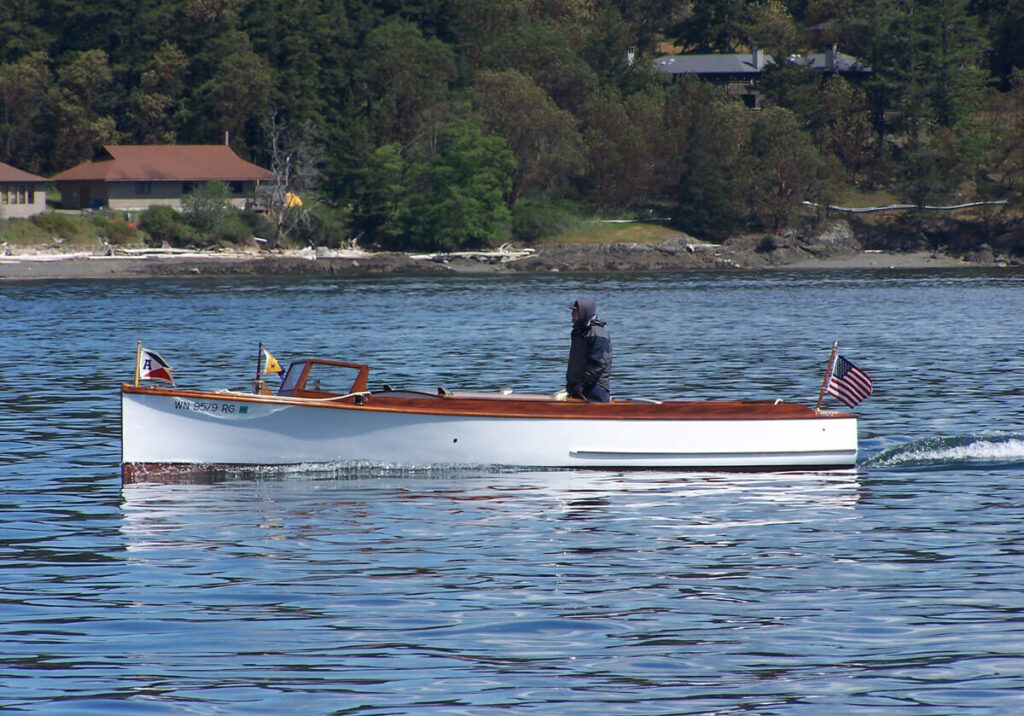Re-Restoring a Washington
Tradition
By Eric Cohen, ’82, Washington Rowing Historian, Coxswain, Rowing Board of Stewards
It was a cool February morning on Lake Washington in the winter of 1936, and the head rowing coach at Washington, Al Ulbrickson, could tell something was missing in his top crew. He had his varsity team – a team that years later would become known as “The Boys in the Boat”- stop their shell. As he did, he also motioned for a man rowing a single scull nearby to come over.
When the single approached, the men recognized the oarsman as George Pocock, the boat-builder whose shop was in the shellhouse. Ulbrickson asked George to give the men some pointers, and backed his sleek wooden launch – The Conny – out of the way. Only the young men could hear Pocock; and as he completed his brief talk and rowed away, the team collected themselves and began another piece. This time it clicked.
From that day forward, Pocock was a regular guest in The Conny. Ulbrickson and Pocock would sit together in the bow compartment, quietly exchanging notes. Six months after that impromptu February meeting on the lake, these two men would be together again; only this time watching from the shores of the Langer See in Germany as the Washington team – now competing as the U.S.A – finished a few feet in front of Italy and Germany to win Olympic Gold.
That victory would propel Ulbrickson into the spotlight, but the coach preferred being on the water. For him, The Conny was where he was comfortable.
Sinking the
Office
The Conny – named for Hiram Conibear, the iconic founder of Washington Rowing (his men referred to him as “Conny”) – is a 28 foot round-bottom, slim –design (six- foot beam) launch that served the head coach at Washington for almost 40 years. For Ulbrickson, who was the head rowing coach at Washington from 1927 through 1959, it was his on-the-water “office” for twenty-seven years.
Likely built at Shertzer Brothers on Lake Union, the documentation on the original Scripps engine showed delivery of the engine in the fall of 1931. The completed vessel was launched in 1932.
Designed with a coach’s compartment in the bow, the bench seat provided unobstructed views of the crews at practice, and had room for a guest or assistant coach. “She was originally built with two key features in mind,” said Kirk Knapp, who now owns the fully restored Conny, “To hold nine men in case a shell swamped in the middle of the lake; and to cut the water with a minimum wake.”
Restored, in this case, may be an understatement. The boat was in multiple pieces when Knapp found her in a University of Washington storage yard in 1975. Struck broadside in 1971 at dusk when two oarsmen took her (and their dates) out for an evening, Conny was salvaged from the water only to end up abandoned in a field.
Knapp – known as “Lucky” at the Crewhouse – had joined the crew team in 1973 but “I was too small to row, and too big to cox. I was given the lightweight cox job, but I almost killed myself trying to make weight. Bob Ernst offered me the frosh manager’s job my sophomore year and I took it. That was my first introduction to the Husky II, the sister boat to the Conny, and I really enjoyed it”, he said. “When I saw Conny in the storage yard my junior year, I came back and tried to get Dick (Erickson, head rowing coach at Washington from 1968-1987) interested. But he had a fully functioning launch. He kept telling me to go pick it up if I wanted it, and finally, in 1978, I was able to do that.”
But busy with work and life, the Conny sat for another two decades before Knapp handed it off to Dave Berg to put her back together in 1996. “I would go up to his place in Bellingham a couple of times a month to see how it was going. It took a full two years for the restoration. But she was beautiful when Dave finished. We launched her on August 12, 1998, I remember that day well.”
Knapp’s favorite story from the restoration was when they were looking for an engine. The original had been replaced at some point in the 50’s or 60’s with a Chrysler Crown, but that engine was long gone. By chance, he heard that Curt Erickson had picked up an old Scripps F-6, and word was the engine was from an old rowing launch. Could it be from the Conny? With Dave and Curt separated by 150 miles, they each went out and measured the mounting holes: one on the boat, and the other on the engine. But they did not match up… until they realized they were measuring from different directions. “That was the moment we knew we had it right. That engine – sitting 150 miles away and salvaged by fortune – was the original. We got it up to Bellingham and it fit into the engine bed perfectly. That was a great day,” said Knapp.
On, You
Huskies
“I can trace my interest and enjoyment of these old boats back to those early years in college when I was first introduced to the Husky II. Driving her on Lake Washington on a clear morning with the sun coming up over the Cascades… that was about as good as it gets for a college kid. But to be encouraged to work on her, and trusted by Bob to keep her in good condition, that was really great. It was a good feeling to have her start up each morning.”
The Husky II was built as a replacement for the Husky, a 36 foot, George Wayland designed (and Shertzer built) launch first delivered to the Washington program in 1923. Powered by a Scripps F-4, she was the first launch specifically designed for the Washington program: original narrow hull and “coaching pit” in the bow, steering from the middle and larger seating deck in the back.
The Alumnus was an almost identical craft added to the Washington fleet in the 20’s, but was infamously involved in one of the more bizarre incidents in the history of American collegiate rowing. During the 1927 Washington/California Dual Race (an annual, traditional regatta now in its 106th year), the Alumnus, loaded with dignitaries and coaches Rusty Callow and Al Ulbrickson, was hit hard broadside by a pleasure craft angling for a better view of the race during the featured 4-mile varsity event.
The violent collision knocked the team manager (with movie camera) into the water and the coaches headlong into the bow compartment, and put a deep gash into the hull of the Alumnus. Barely making it to shore before she swamped, the team fared no better: “The varsity never could get their race together,” states the Washington Rowing History website in a review of the 1927 season, “and who knows what the sight of seeing their coach mauled did to their collective psyche, but they fell three lengths behind the Bears and lost The Dual for the first time since 1921.”
Space for
Stowaways
The fact the Alumnus was in Oakland for that race in 1927 illustrates the importance the coaches put in their launches. By the mid-twenties, the teams would not just travel with their shells and oars across country; they would bring the coach’s launch as well. Hoisted out of the water, the craft would be carefully fitted into a boxcar to ride the rails to the race destination. That included the National Championships held in Poughkeepsie NY, and there are many stories of team members – who did not make the roster of one of the racing boats – finding a spot inside the stored launch to stowaway for the coast to coast trip. In the early 30’s, one of those was a young Bobby Moch (the coxswain of the “Boys in the Boat” 1936 gold medal eight), who as a sophomore made the trip back east by hiding in the Conny. “I hid in there until the train was underway, then some of the guys came back and got me out. But that’s how I made it to Poughkeepsie that year,” said Moch in a 2002 interview.
For two decades the Husky, and the Conny, were the workhorses of the Washington program, but following WWII the Husky II would replace the Husky. The new launch was designed and built with the same specs as the Conny: round bottom, 28 feet with a 6 foot beam. Built by H.A. Long in Olympia, the Husky II came equipped with a Chrysler Royal straight 8 engine. “When we took that engine out to have it overhauled in the late 70’s, our technicians told us it was likely surplused from WWII,” said Bob Ernst, the former, longtime rowing coach at Washington. “They could not believe it lasted as long as it did.” The Royal would be replaced by a Chevy II in the early 80’s.
